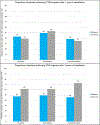Comparison of traditional and closed loop vagus nerve stimulation for treatment of pediatric drug-resistant epilepsy: A propensity-matched retrospective cohort study
- PMID: 34872020
- PMCID: PMC11423706
- DOI: 10.1016/j.seizure.2021.11.016
Comparison of traditional and closed loop vagus nerve stimulation for treatment of pediatric drug-resistant epilepsy: A propensity-matched retrospective cohort study
Abstract
Objective: For epilepsy patients with drug-resistant, unresectable epilepsy, vagus nerve stimulation (VNS) is an option for seizure control. Approximately 40-70% of patients will achieve ≥50% seizure reduction with VNS. New closed loop VNS models detect ictal tachycardia and responsively stimulate the vagus nerve. The effectiveness of closed loop VNS compared to traditional VNS for pediatric epilepsy is unknown.
Methods: An 11-year retrospective electronic medical record review at Children's Hospital of Pittsburgh was performed. Patients with drug-resistant epilepsy who underwent VNS implantation were included. Patients were divided into groups based on VNS model: traditional versus closed loop. Those who transitioned from traditional to closed loop VNS were excluded. Given potential for selection bias, propensity scores matching was utilized to compare traditional to closed loop VNS patients. Patients with focal versus generalized epilepsy were also separately analyzed. The primary outcome was "VNS response", defined as at least 50% seizure frequency reduction from baseline.
Results: A total of 320 patients were included in this sample. The percentage of matched patients (total n = 220: n = 179 traditional VNS, n = 41 closed loop VNS) who responded to VNS after one year of therapy was 43% for traditional VNS and 39% for closed loop VNS (p = 0.64). After two years of therapy, a higher proportion of closed loop VNS patients than traditional VNS patients responded to VNS among all subgroups, though no differences were statistically significant (p>0.05). Notably, for those with generalized epilepsy, 73% of closed loop patients responded to VNS compared to only 46% of traditional patients (p = 0.10). After two years of VNS therapy, patients were taking approximately the same quantity of antiseizure medications as baseline (change of +0.074 +/- 0.90 ) with no difference between VNS models (p = 0.87).
Significance: Among pediatric patients with drug-resistant epilepsy, closed loop VNS trends towards a higher rate of VNS response after two years of treatment, especially among generalized epilepsy patients. Neither model of VNS allows patients to reduce antiseizure medication quantity after two years.
Keywords: Child; Neurosurgery; Refractory; Seizure; VNS.
Copyright © 2021 British Epilepsy Association. Published by Elsevier Ltd. All rights reserved.
Conflict of interest statement
Figures


Similar articles
-
Investigation of the effectiveness of vagus nerve stimulation for pediatric drug-resistant epilepsies secondary to nonaccidental trauma.Childs Nerv Syst. 2023 May;39(5):1201-1206. doi: 10.1007/s00381-022-05817-9. Epub 2023 Jan 5. Childs Nerv Syst. 2023. PMID: 36602582
-
Effect of vagus nerve stimulation on emergency department utilization in children with drug-resistant epilepsy: a retrospective cohort study.J Neurosurg Pediatr. 2024 Jun 21;34(3):260-267. doi: 10.3171/2024.4.PEDS23310. Print 2024 Sep 1. J Neurosurg Pediatr. 2024. PMID: 38905712
-
Development of a clinical model to predict vagus nerve stimulation response in pediatric patients with drug-resistant epilepsy.J Neurosurg Pediatr. 2023 Feb 17;31(5):476-483. doi: 10.3171/2023.1.PEDS22312. Print 2023 May 1. J Neurosurg Pediatr. 2023. PMID: 36805960
-
Learnings from 30 years of reported efficacy and safety of vagus nerve stimulation (VNS) for epilepsy treatment: A critical review.Seizure. 2020 Dec;83:104-123. doi: 10.1016/j.seizure.2020.09.027. Epub 2020 Oct 10. Seizure. 2020. PMID: 33120323 Review.
-
Vagus nerve stimulation for drug-resistant epilepsy.Pract Neurol. 2020 May;20(3):189-198. doi: 10.1136/practneurol-2019-002210. Epub 2019 Dec 31. Pract Neurol. 2020. PMID: 31892545 Review.
Cited by
-
Neurostimulation as a Method of Treatment and a Preventive Measure in Canine Drug-Resistant Epilepsy: Current State and Future Prospects.Front Vet Sci. 2022 Jun 16;9:889561. doi: 10.3389/fvets.2022.889561. eCollection 2022. Front Vet Sci. 2022. PMID: 35782557 Free PMC article. Review.
-
Importance of timing optimization for closed-loop applications of vagus nerve stimulation.Bioelectron Med. 2023 Apr 27;9(1):8. doi: 10.1186/s42234-023-00110-9. Bioelectron Med. 2023. PMID: 37101239 Free PMC article. Review.
-
Investigation of the effectiveness of vagus nerve stimulation for pediatric drug-resistant epilepsies secondary to nonaccidental trauma.Childs Nerv Syst. 2023 May;39(5):1201-1206. doi: 10.1007/s00381-022-05817-9. Epub 2023 Jan 5. Childs Nerv Syst. 2023. PMID: 36602582
-
Emerging Trends in Neuromodulation for Treatment of Drug-Resistant Epilepsy.Front Pain Res (Lausanne). 2022 Mar 21;3:839463. doi: 10.3389/fpain.2022.839463. eCollection 2022. Front Pain Res (Lausanne). 2022. PMID: 35386582 Free PMC article. Review.
References
-
- Russ SA, Larson K, Halfon N. A national profile of childhood epilepsy and seizure disorder. Pediatrics. 2012;129(2):256–264. - PubMed
-
- Kalilani L, Sun X, Pelgrims B, Noack-Rink M, Villanueva V. The epidemiology of drug-resistant epilepsy: A systematic review and meta-analysis. Epilepsia. 2018;59(12):2179–2193. - PubMed
-
- Tzadok M, Harush A, Nissenkorn A, Zauberman Y, Feldman Z, Ben-Zeev B. Clinical outcomes of closed-loop vagal nerve stimulation in patients with refractory epilepsy. Seizure. 2019;71:140–144. - PubMed
MeSH terms
Grants and funding
LinkOut - more resources
Full Text Sources
Medical

